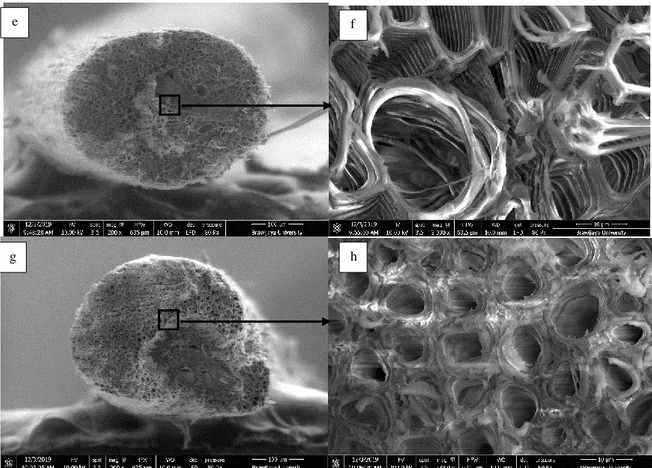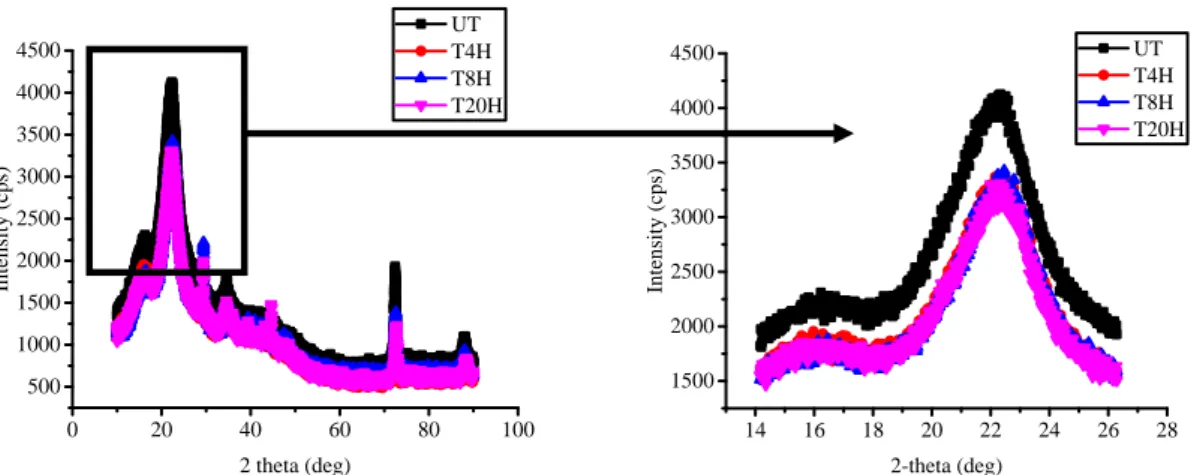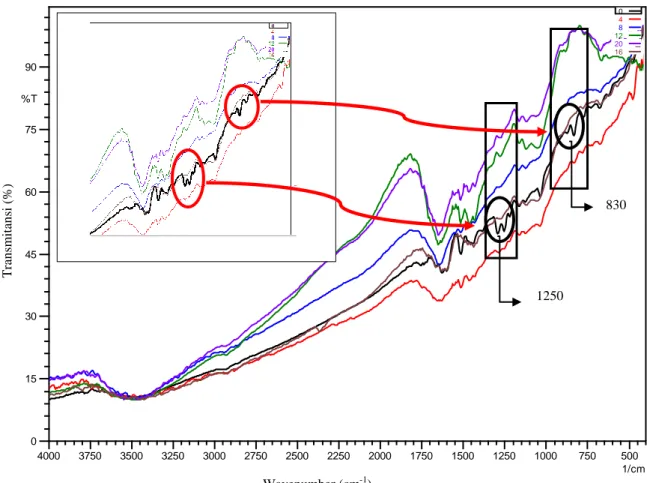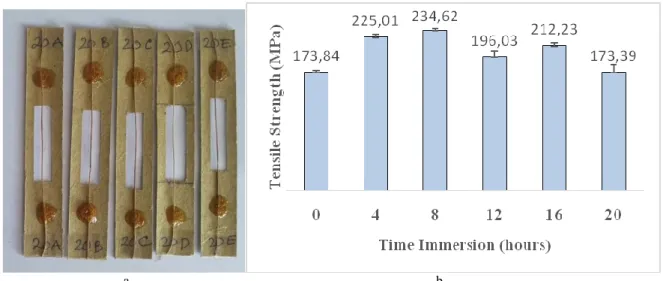第 55 卷 第 3 期
2020 年 6 月
JOURNAL OF SOUTHWEST JIAOTONG UNIVERSITY
Vol. 55 No. 3
June 2020
ISSN: 0258-2724 DOI:10.35741/issn.0258-2724.55.3.52
Research articleMaterial Science
T
HE
E
FFECT OF
I
MMERSION
T
IME OF
C
OCONUT
F
IBER IN
L
IMESTONE
W
ATER ON
T
ENSILE
S
TRENGTH AND
S
URFACE
M
ORPHOLOGY
椰子油在石灰石水中的浸入时间对拉伸强度和表面形态的影响
Sutrisno a, Rudy Soenoko b, Yudy Surya Irawan b, Teguh Dwi Widodo ba Department of Mechanical Engineering, Universitas Merdeka Madiun Madiun, Indonesia, sutrisno@unmer-madiun.ac.id
b Department of Mechanical Engineering, Universitas Brawijaya
Malang, Indonesia, rudysoen@ub.ac.id, yudysir@ub.ac.id, widodoteguhdwi@ub.ac.id
Received: March 1, 2020 ▪ Review: May 20, 2020 ▪ Accepted: May 30, 2020
This article is an open access article distributed under the terms and conditions of the Creative Commons Attribution License (http://creativecommons.org/licenses/by/4.0)
Abstract
This study aims to identify the effect of immersion of coconut fiber in limestone water on surface morphology and tensile strength, including chemical reactions during immersion. Coconut coir fibers were immersed in a solution of limestone water for 0, 4, 8, 12, 16, and 20 hours, with a mass fraction of limestone of 5%, then dried for 1 hour. Coconut fiber was characterized by a single fiber tensile testing machine, Scanning Electron Microscope, X-ray diffractometer, and Fourier transform infrared spectrometer. The results showed that the percentage of 5% with 8 hours of immersion in the fiber had a cleaner surface morphology with a tensile strength of 234.62 MPa. Therefore, as an alternative to improving the characteristics of a single thread, immersion in limestone water needs to be applied.
Keywords: Coconut Fiber, Limestone Water, Surface Morphology, Tensile Strength
摘要 本研究旨在确定将椰子纤维浸入石灰石水中对表面形态和拉伸强度的影响,包括浸入过程中 的化学反应。将椰子椰壳纤维浸入石灰石水溶液中 0、4、8、12、16 和 20 小时,石灰石的质量分 数为 5%,然后干燥 1 小时。用单纤维拉伸试验机,扫描电子显微镜,X 射线衍射仪和傅立叶变 换红外光谱仪表征椰子纤维。 结果表明,浸渍在纤维中 8 小时的 5%的百分数具有更清洁的表面 形态,抗张强度为 234.62 兆帕。因此,作为改善单线特性的替代方法,需要浸入石灰石水中。 关键词: 椰子纤维,石灰石水,表面形貌,拉伸强度
I. I
NTRODUCTIONThe industrial world uses many composite materials, many of which use synthetic materials as reinforcement. The process of making these synthetic materials results in environmental pollution. It is necessary to make an effort to replace these with environmentally friendly materials. Efforts to reduce the use of synthetic materials (composite reinforcing materials), which are a cause of environmental pollution, need to be studied in order to find replacements for synthetic materials.
Natural fiber-based composite materials can be recycled or reused even though their properties are not as good as the original [1]. The use of natural fibers by industrial programs are to create environmentally friendly products. The use of composite materials has increased with advances in technology. The preservation process prevents from fungal growth due to exposure to weather and as protection toward insects such as drywood termites or soil termites.
Untreated natural fibers used as reinforcement in composite materials cannot be bonded to the matrix. Natural fibers require special treatment so that they can bind to the form maximally. Surface treatments of natural fibers are used to increase adhesion and other mechanical properties necessary for use in composite materials [2], [3], [4], [5]. Some scientists are concerned that cellulose-based natural fibers have hydrophilic properties that are not compatible with the hydrophobic polymer matrix used in composites. One of the natural fibers used as composite reinforcement material is coconut coir fiber. Coconut fiber is very abundant, but the fiber has not been used optimally. Indonesia has the largest coconut area in the world, reaching four million hectares, which is 31.2% of the total area of coconut plantations in the world [6].
Chemical treatment can lead to degradation of the fiber, which can result in surface damage, thereby decreasing the mechanical properties of the thread. As a result, there is a need for a treatment that can clean the thread without damaging the cellulose. Chemical treatment can reduce the hydrophilic nature of the fiber so that the thread can interact with the polymer matrix maximally [7].
The characteristics of natural fibers are affected by the processing and treatment of textures. Some of the treatments used can include chemical treatment or natural treatment with natural substances. Some chemical treatments include alkali treatment [8], [9], [10], [11], [12], [13]. Both chemical treatment and natural treatment with natural ingredients use alkaline
substances. One natural treatment of fiber with natural materials, for example, is soaking the thread in seawater [14]. The treatment of bamboo by immersing it in river water and seawater results in a decreased level of fungal attack on bamboo reinforcement. Bamboo reinforcement with a non-immersion treatment was found to be overgrown with mushrooms, whereas bamboo bars that were soaked in seawater and soaked in river water long that had no mushrooms [15].
Another natural treatment is soaking fibers in limestone water. Bamboo as a home-making material is soaked in lime water first with the aim that bamboo will become more durable. Preservation has often been carried out by rural communities, especially in the Java region which is one of the local wisdom cultures in the bamboo preservation business [16].
Limestone is a sedimentary rock composed of calcium carbonate (CaCO3). Lime is one of the
natural substances that can be used in traditional bamboo preservation. Untreated natural fibres used as building materials are often mouldy and eaten by termites. Ca(OH)2 limestone water is
natural and in large quantities. The powder was is dissolved in water to form a saturated solution of calcium hydroxide (Ca(OH)2). The bamboo was
is soaked in this solution for approximately one month [17]. Ca(OH)2 limestone water solution
does not endanger health, as a fiber treatment media to improve mechanical properties and clean fibers. Ca(OH)2 limestone water solution
for processing papaya chips will yield a more savoury, crispy result [18].
There is an abundance of limestone in Indonesia. The rock is spread almost evenly throughout the Indonesian Archipelago. According to the Center for Research and Development of Mineral and Coal Technology [6], most of the limestone reserves in Indonesia are in East Java. There has been extensive research into the processing of coconut fibre [19], [20], [21], [22], [23], [24], but not into treating the fibre by immersing it in limestone water. Based on this description, Ca(OH)2 limestone
water is thought to make natural fibres stronger, more durable, and pest-resistant.
II. M
ATERIAL ANDM
ETHODS A. Materials Coconut fibre from Wonogiri, Central Java, Indonesia. The fibre was taken from fruits 12-14 months old and picked from trees 10-12 years old.
Distilled water, used as a solvent for the limestone.
Limestone, taken from Ponorogo, East Java. The limestone was used to immerse the coconut fibre with a weight fraction of 5%. The Ca(OH)2 limestone was dissolved in distilled
water with composition as shown in Table 1.
a
b
c
d
Figure 1. a. Coconut tree; b. Coconut coir; c. Coconut fiber; d. Limestone water
B. Methods
1) Treatment of Coconut Fiber
Coconut coir fibers were separated from the meat, then soaked in limestone water according to Table 1.
Table 1.
Coconut Fiber treatments
No Notation Immersion time (hours) Limestone (% wt) 1 UT a 0 5 2 T4H b 4 5 3 T8H c 8 5 4 T12H d 12 5 5 T16H e 16 5 6 T20H f 20 5 a Untreated spesimen b
Immersion time of 4 hours
c
Immersion time of 8 hours
d
Immersion timr of 12 hours
e
Immersion time of 16 hours
f
Immersion time of 20 hours
Coconut coir fibers were treated by soaking according to the table, then dried at room temperature.
2) Surface Morphology of Coconut Fiber
The fiber surface morphology of each treatment was observed using a Scanning Electron Microscope (SEM). The morphological characterization were examined by SEM (FEI - Quanta FEG 650) in high vacuum mode at an accelerating voltage of 20 kV. SEM manage by Laboratorium Sentral Ilmu Hayati, Universitas Brawijaya, Malang, Indonesia.
3) X-Ray Diffractometry (XRD) Coconut Fiber
The X-Ray Diffraction (XRD) test was used to analyze the crystal structure of a material because each element or compound has a certain diffraction pattern. On the diffractogram, there is a link between the angle of the 2Ø and the
intensity of the number of detectors already in the XRD system. The percentage of crystallinity (% Cr) is calculated as follows:
(1)
with
% Cr: Crystallinity degree (%)
I10: Maximum intensity peak associated with the
crystal planes
I60: Amorfiffraction intensity, taken the lowest
value on an angle of 2θ
I10 and I60 are amorphous crystal intensities on a
scale of 2θ.
4) Fourier Transform Infrared (FTIR) Coconut Fiber Spectroscopy
Effects of chemical treatment with alkali treatment on the fiber surface can be observed using FTIR spectroscopy. Chemical group changes that occur in the fibre due to chemical treatment are known by FTIR spectroscopy [25].
5) Tensile Strength of a Single Fiber
Preparation of coconut coir fiber specimens began with fibers from meat, soaking the thread in limestone water according to the table. The
sample for each treatment was 5, and the complete specimen was 30 samples. Tensile testing, according to ASTM D-3379 [26].
Figure 2. Single fiber test specimen [26]
III. R
ESULT ANDD
ISCUSSION A. Surface Morphology of Coconut FiberFigure 3 shows the surface morphology of the coconut husk. Figure 1 (a) is a fiber surface without treatment, while Figure 1 (b, c, and d) shows the surface of coconut fiber with limestone water immersion treatment.
Glue Paper Fiber Glue
a b
Figure 3. Scanning Electronic Microscopy (SEM) images of coconut fiber: a-b - untreated specimen; c-g - limestone water treated fibers; c-d - Immersion time of 4 hours; e-f - Immersion time of 8 hours; g-h - Immersion time of 20 hours
Figure 3a, b shows the surface of coconut fiber without immersion. The surface of coconut fiber shows a dirty surface (the surface of the fiber is covered with wax and grease). Figure 3c, d shows a rough surface because the OH content of the fiber group has been degraded, and the surface has become rough, grooved, and porous due to the effects of limestone immersion. Soaking makes surface roughness, increased roughness resulting from degradation of lignin on the surface of the fiber, enriched with the composition of elements H and O in lignin compounds along with the density of C bonds in the fiber [22].
Figure 3e, f, the surface of the fiber looks cleaner and rougher when compared to Figure 3b. This is because the elements of lignin, hemicellulose and pectin in the fiber have been degraded by limestone water. Soaking coconut fiber for 8 hours can clean the surface of the fiber. The picture shows an extensive fiber surface, does not experience surface defects, and a good fiber groove like a spiral. Scanning Electron
Microscopy (SEM) is one of the most powerful characterization techniques for assessing the effect of surface modification on fibers. However, only a few physical changes on the surface of the fiber can be seen. Formation of bonds between fibers and modification cannot be determined quantitatively [27].
Figure 3g, h shows the surface of the fiber, which is not good (it can be said to be damaged) this is due to the soaking of the fiber for too long. This results in a damaged fiber surface. Too long immersion causes cellulose to degrade [7], [28].
B. Fiber XRD Analysis
Figure 4 shows the X-ray diffraction pattern of coconut fiber without treatment and with treatment. The peak intensity of each treatment occurred in an area of around 22o. The peak intensity of each treatment corresponds to the reflection of the crystallographic field, representing the crystalline peaks of cellulose [29].
e f
0 20 40 60 80 100 500 1000 1500 2000 2500 3000 3500 4000 4500 Intensi ty (c ps) 2 theta (deg) UT T4H T8H T20H 14 16 18 20 22 24 26 28 1500 2000 2500 3000 3500 4000 4500 Intensi ty (c ps) 2-theta (deg) UT T4H T8H T20H
Figure 4. X-ray diffraction profile for fibers without the treatment and treatment of limestone water immersion
Table 2 that the relative intensity of UT on a scale of 2θ is 2300 (I10) and 4084 (I60). The
percentage of crystallinity (% Cr) of UT has been found 63.97. Whereas T4H which was quenched with limestone for 4 hours showed relative intensity of 1875 (I10) and 3305 (I60) so that the
percentage of fiber critilicity was 63.8. The relative intensity of T8H soaked in limestone for 8 hours was 1818 (I10) and 3369 (I60). Percentage
of crystallinity of fibers treated with 8 hours 64.95. The relative intensity of the fiber soaked for 20 hours is 1848 (110) and 3310 (I60). The
percentage of fiber crystallinity was found 64.23.
Table 2.
Percentage of crystallinity of each fiber
Code I10 (cps) I60 (cps) Cr (%)
UT 2300 4084 63,97
T4H 1875 3305 63,80
T8H 1818 3369 64,95
T20H 1848 3310 64,23
Immersion coconut coir fiber in limestone water with soaking and without soaking can be seen in Figure 4. The crystallinity of coconut fiberis increasing with 8 hours soaking time. Figure 4 shows the immersion time of 8 hours of removal of amorphous components and other
impurities. The loss of amorphous components and impurities makes the cellulose chain arrangement increasingly better [29]. Soaking coconut fiber with 12 hours of crystallinity decreases, this causes damage to the structure of cellulose [30].
C. FTIR Fiber Analysis
Spectra results of FTIR fiber test without and with limestone immersion can be seen in Figure 5. Figure 5 shows a functional group that appears on fibers without immersion and with immersion. Texture without soaking and with soaking increases in intensity. Figure 5 shows the peak around the wavenumber region 3450 cm-1 which is related to the vibration strain of the O-H function group [31], [32]. Absorption that occurs at the peak of 2940 cm-1 is related to asymmetric strain vibrations from the C-H bond [33]. Figure 5 shows that limestone water immersion can affect the wave peak where the immersion can break the chain of fiber compounds such as lignin and hemicellulose [33], [34], [35]. The process of degradation in the process of fiber immersion can reduce the O-H group in the range of wave region 3750 - 3250 cm-1.
500 750 1000 1250 1500 1750 2000 2250 2500 2750 3000 3250 3500 3750 4000 1/cm 0 15 30 45 60 75 90 %T 0 4 8 12 20 16 Wavenumber (cm-1)
Figure 5. FTIR test results of fiber without immersion and limestone water immersion fiber
The crystallinity peak in the wavenumber area was of 1630-1030 cm-1 due to the vibrations made by the carbon and hydrogen groups [28]. The treatment make degradation on the fibers so that can clean fiber from dirt (lignin and hemicellulose) and became rough and grooved (the surface of the fiber becomes rough and grooved is expected to bond well with the matrix). The absorption in the wavelength region of 800-400 cm-1 occurs
because C-C vibrations form a tighter bond, increasing the tensile strength of the thread. The fibre’s FTIR spectrum is different because it is not soaked. Its absorbed texture is seen in Figure 5, in wave frames 1256 cm-1 and 830 cm-1. These frames are set in black graph lines and were not treated. In Figure 5 there are still impurities (lignin and hemicellulose) [36].
Table 3.
The peaks of FTIR transmittance of fiber without treatment and with treatment
Frequency number Assigned functional groups Reference
3450 O-H bending method principally connected to the
presence of water in hemicellulose
[31], [32]
2940 C- H stretching in aromatic methoxyl assembly
and methylene group
[33]
1630 Aromatic C- H in smooth deformation and C- O
stretching of lignin
[28] 670 The C-H winding of formless and crystalline
cellulose
[5]
D. Tensile Strength of Coconut Fiber
Figure 6a shows a sample of a single fiber tensile test specimen. Figure 6b shows the results of tensile strength test of single fiber coconut fiber without treatment and with limestone water immersion treatment. The tensile strength of natural fibers is essential for bio-composite
applications, so specific therapies are needed to improve the characteristics of mechanical properties. As one of the natural fibers, coconut coir fiber samples are treated naturally and show significant results on increasing the tensile strength of coconut coir fibers.
Tran sm it an si ( % ) 1250 830
a b
Figure 6. (a). Samples of single fiber test specimens; (b). Single fibertensile test results
Figure 6b shows the tensile strength of fibers without treatment 173.84 MPa, the increase in tensile strength occurs in the immersion treatment 4,8.12, and 16 hours, each value 225.01; 234.62; 196.03; and 212.23 MPa. Immersion 20 hours tensile strength decreased by 173.39 MPa, due to immersion that is too long, causing degradation of the cellulose fiber elements [29], [37], [38]. Increased tensile strength in the treatment due to carbon bonds and lignin and hemicellulose degradation in the fiber. Immersion treatment for 8 hours showed the highest tensile strength, and therefore this study recommended a maximum immersion treatment of 8 hours with 5% limestone percentage.
IV. C
ONCLUSIONThe results showed that the immersion treatment of coconut fiber in a solution of lime water could clean the surface of the yarn and increase the tensile strength of the coconut fiber. Chemical analysis, XRD, and FTIR show loss of amorphous material. XRD analysis confirmed at 8 hours immersion, the crystallinity showed a 64.95% rate, which was higher when compared to other treatments. The results showed that the immersion treatment of coconut fiber in a solution of lime water could clean the surface of the yarn and increase the tensile strength of the coconut fiber. Chemical analysis, XRD, and FTIR show loss of amorphous material. XRD analysis confirmed at 8 hours immersion, the crystallinity showed a 64.95% rate, which was higher when compared to other treatments. FTIR analysis shows that the fiber without treatment still shows peaks (1250 and 830), while those with peak treatment are not visible. This treatment shows that by soaking limestone, water can eliminate hemicellulose and lignin.
Immersion time of 8 hours and limestone mass concentration of 5% occurred the strength of coconut fiber reached a maximum point of 234.62 MPa.
A
CKNOWLEDGMENTThis study is supported by Kemenristekdikti through the scheme of BPP-DN 2017-2020 in term of providing financial supports for this study.
R
EFERENCES[1]
RODIAWAN, R., SUHDI, S., and
ROSA, F. (2017) Analysis of the Properties
of
Natural
Fibers
as
a
Composite
Strengthener Judging From Mechanical
Strength. Turbo Jurnal Teknik Mesin
Universitas Muhammadiyah Metro, 5 (1), pp.
39-43.
[2]
MWAIKAMBO, L.Y. and ANSELL,
M.P. (2002) Chemical modification of hemp,
sisal, jute, and kapok fibers by alkalization.
Journal of Applied Polymer Science, 84 (12),
pp. 2222-2234.
[3]
SURYANTO, H., MARSYAHYO,
E., IRAWAN, Y.S., and SOENOKO, R.
(2014) Effect of alkali treatment on
crystalline structure of cellulose fiber from
mendong (fimbristylis globulosa) straw. Key
Engineering Materials, 594-595, pp.
720-724.
[4]
SOOD, M. and DWIVEDI, G.
(2018) Effect of fiber treatment on flexural
properties of natural fiber reinforced
composites: A review. Egyptian Journal of
[5]
MUSLIMIN, M., KAMIL, K., BUDI,
S.A.S., and WARDANA, I.N.G. (2019)
Effects of Liquid Smoke on the Chemical
Composition and Thermal Properties of
Sago Fiber. Journal of Southwest Jiaotong
University,
54
(6).
Available
from
http://jsju.org/index.php/journal/article/view
/417
.
[6]
PONOROGO, S. (2017) Indonesia,
the Largest Coconut Producing Country in
the World. Ponorogo Regency.
[7]
WIELAGE,
B.,
LAMPKE,
T.,
MARX, G., NESTLER, K., and STARKE,
D.
(1999)
Thermogravimetric
and
differential scanning calorimetric analysis of
natural
fibres
and
polypropylene.
Thermochimica Acta, 337 (1-2), pp. 169-177.
[8]
ESSABIR, H., BOUJMAL, R.,
BENSALAH, M.O., RODRIGUE, D.,
BOUHFID, R., and QAISS, A.E.K. (2016)
Mechanical and thermal properties of hybrid
composites: Oil-palm fiber/clay reinforced
high density polyethylene. Mechanics of
Materials, 98, pp. 36-43.
[9]
NOPPARUT,
A.
and
AMORNSAKCHAI, T. (2016) Influence of
pineapple leaf fiber and it’s surface
treatment on molecular orientation in, and
mechanical properties of, injection molded
nylon composites. Polymer Testing, 52, pp.
141-149.
[10]
ALSHAAER,
M.,
MALLOUH,
S.A.A., AL-KAFAWEIN, J.K., AL-FAIYZ,
Y.S., FAHMY, T.P., KALLEL, A., and
ROCHA,
F.
(2017)
Fabrication,
microstructural
and
mechanical
characterization of Luffa Cylindrical Fibre -
Reinforced geopolymer composite. Applied
Clay Science, 143, pp. 125-133.
[11] RASHID, B., LEMAN, Z., JAWAID,
M., GHAZALI, M.J., ISHAK, M.R., and
ABDELGNEI, M.A. (2017) Dry sliding
wear behavior of untreated and treated sugar
palm fiber filled phenolic composites using
factorial technique. Wear, 380-381, pp.
26-35.
[12]
HAILONG, W., YUEGING, L.,
GUANGYU,
P.,
XIAYUN,
S.,
and
QIMING, Y. (2017) Effect of Admixtures
on Tensile Behavior of Fiber Reinforced
Cementitious
Composites.
Journal
of
Southwest Jiaotong University, 52 (1), pp.
61-68.
[13]
MADHU,
P.,
SANJAY,
M.R.,
SENTHAMARAIKANNAN, P., PRADEEP,
S.,
SARAVANAKUMAR,
S.S.,
and
YOGESHA, B. (2019) A review on
synthesis
and
characterization
of
commercially available natural fibers: Part-I.
Journal of Natural Fibers, 16 (8), pp.
1132-1144.
[14]
MARDIN, H., WARDANA, I.N.G.,
PRATIKTO, SUPRAPTO, W., and KAMIL,
K. (2016) Effect of Sugar Palm Fiber
Surface on Interfacial Bonding with Natural
Sago Matrix. Advances in Materials Science
and Engineering, 2016, 9240416.
[15]
POJOH, B. (2017) The Effect of
Soaking in River and Sea Water on the
Resilience
of
Petung's
Bamboo
Reinforcement from Tomohon. Jurnal
Penelitian Teknik Industri, 9 (1), pp. 37-48.
[16]
SURIANI, E. (2018) Study of
Variation Methods and Preservatives in the
Bamboo-Wood Preservation Process in
Indonesia. EMARA: Indonesian Journal of
Architecture, Vol 4 No 1-Desember 2018
ISSN 2460-2477 (In Imdonesia : Kajian
Terhadap Variasi Metode dan Bahan
Pengawet pada Proses Pengawetan
Bambu-Kayu di Indonesia).
[17]
FRANSISKA, D., PERMATASARI,
A.I., HARYATI, S., and MUNANDAR, A.
(2014)
Addition of Calcium Carbonate on the Production of Instant Pudding Powder Containing Alginate. Jurnal Pascapanen danBioteknologi Kelautan dan Perikanan, 9 (1), pp.
69-81.
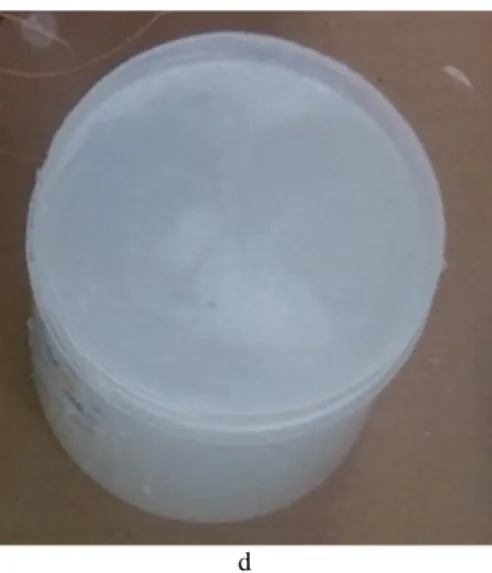
![Figure 2. Single fiber test specimen [26]](https://thumb-ap.123doks.com/thumbv2/123deta/8046065.1255018/4.892.461.775.141.339/figure-single-fiber-test-specimen.webp)
